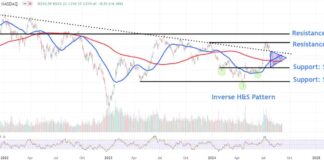Navigating the Stock Market: How Investors Prepare for Autumn Chills
As investors return from their summer holidays, they may be met with a sense of unease as they check their portfolios. The stock market has experienced a rocky start to September, with America’s benchmark S&P 500 index dropping by 2% on its first day of trading. This downward trend has been mirrored in European and Japanese markets as well, indicating a shift from the previous period of market calm that was prevalent before Labor Day.
The contrast is stark when compared to the end of August when American share prices were just below an all-time high reached in July. Similarly, European stocks were performing well, and Japanese equities were close to their peak. The positive momentum was further supported by a cooling trend in rich-world inflation, setting the stage for the Federal Reserve to potentially begin cutting interest rates at their upcoming meeting on September 17th and 18th.
Market Volatility and Investor Sentiment
The recent volatility in the stock market has left many investors feeling apprehensive about the future. The sharp declines in key indices have raised concerns about the sustainability of the long-running bull market. Investor sentiment, which was buoyant just a few weeks ago, has now turned cautious as uncertainty looms over the global economy.
One of the main factors contributing to this market turbulence is the ongoing trade war between the United States and China. The tit-for-tat tariffs imposed by both countries have created a sense of instability in the markets, with investors unsure of how the situation will ultimately play out. The escalating tensions have also had a ripple effect on other economies, leading to concerns about a potential global economic slowdown.
Strategies for Navigating Market Uncertainty
In times of market uncertainty, it is crucial for investors to have a well-thought-out strategy in place to weather the storm. Diversification is key to mitigating risk, as spreading investments across different asset classes can help cushion the impact of market fluctuations. Additionally, maintaining a long-term perspective and not succumbing to short-term market noise is essential for staying focused on your investment goals.
Another strategy that investors can employ during volatile market conditions is to stay informed and continuously monitor economic and market trends. Keeping abreast of the latest developments can help investors make informed decisions about their portfolios and adjust their strategies accordingly. Seeking professional advice from financial advisors can also be beneficial in navigating uncertain market environments.
Opportunities Amidst Market Turbulence
While market volatility can be unsettling for investors, it also presents opportunities for those who are willing to take a contrarian approach. Buying undervalued stocks during market downturns can yield significant returns when the market eventually rebounds. Warren Buffett famously said, “Be fearful when others are greedy and greedy when others are fearful,” highlighting the importance of contrarian investing in volatile markets.
Another way to capitalize on market turbulence is to focus on dividend-paying stocks, which can provide a steady stream of income regardless of market conditions. Companies that have a history of paying consistent dividends are often seen as stable investments, making them attractive options during uncertain times. Additionally, investing in defensive sectors such as healthcare and consumer staples can provide a level of protection during market downturns.
In conclusion, navigating the stock market during periods of uncertainty requires a combination of caution, strategy, and diligence. By diversifying your portfolio, staying informed, and seizing opportunities amidst market turbulence, investors can position themselves for long-term success in an ever-changing market environment.

















